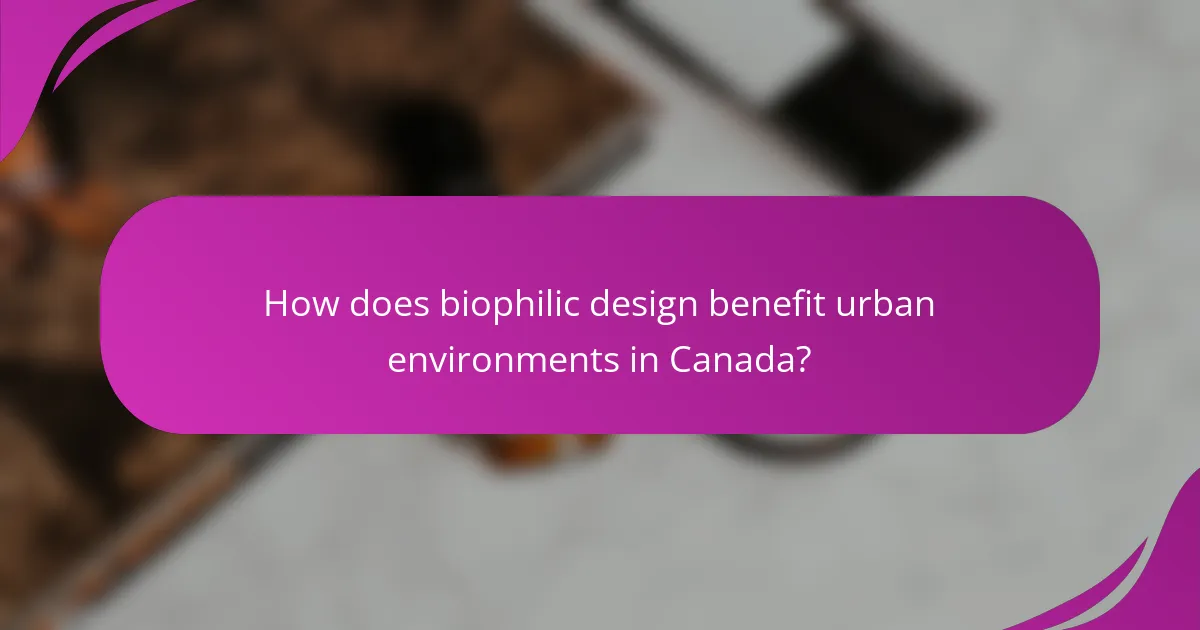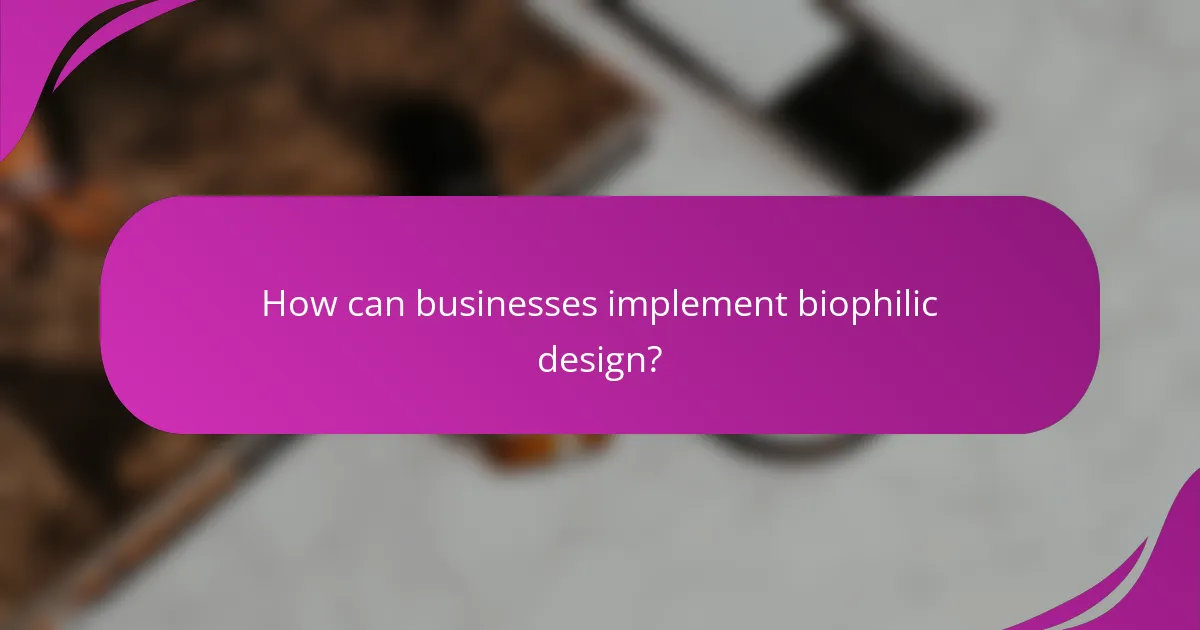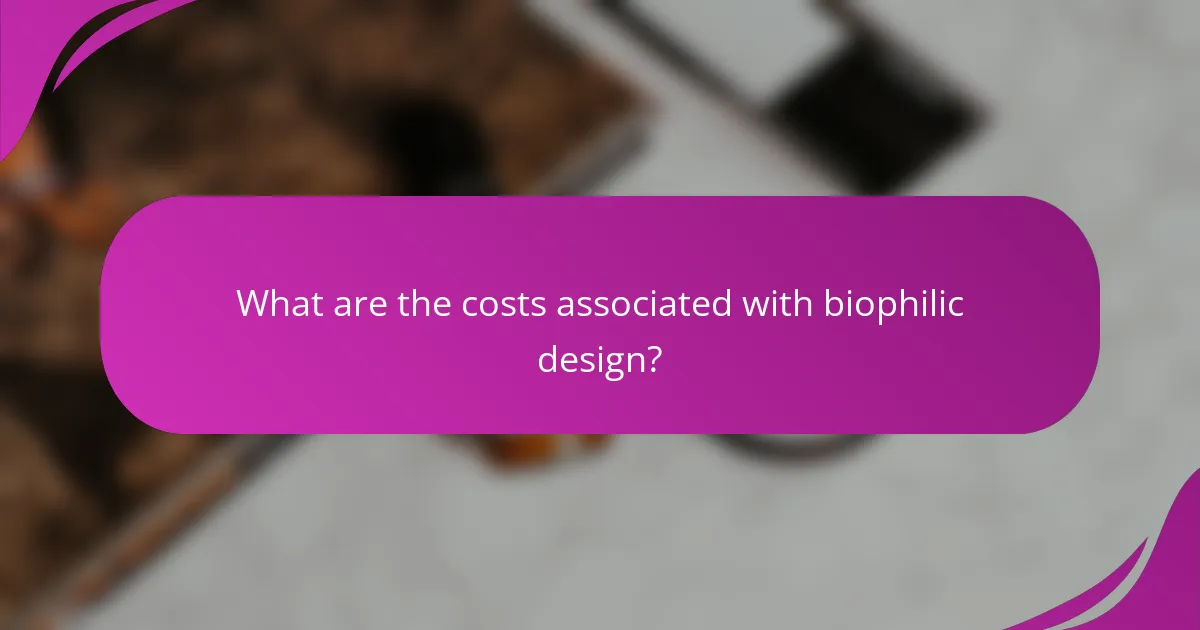Biophilic design is an innovative approach that integrates natural elements into urban environments, promoting healthier living spaces and enhancing the quality of life for residents. By employing techniques that connect people with nature, this design philosophy not only supports ecological sustainability but also boosts productivity and creativity in various settings, including workplaces. Businesses that adopt biophilic design can create more inviting and health-oriented environments, ultimately benefiting both employees and the broader community.

How does biophilic design benefit urban environments in Canada?
Biophilic design enhances urban environments in Canada by integrating natural elements into city planning, which fosters healthier living spaces. This approach not only improves residents’ quality of life but also supports ecological sustainability and economic growth.
Improves mental health and well-being
Biophilic design significantly boosts mental health by reducing stress and anxiety levels. Incorporating natural light, plants, and water features into urban spaces can create calming environments that promote relaxation and enhance overall well-being.
For example, parks and green roofs in cities like Toronto and Vancouver provide residents with accessible nature, which has been linked to improved mood and cognitive function. Regular exposure to these elements can lead to lower rates of depression and increased happiness.
Enhances biodiversity in urban areas
Integrating biophilic design into urban planning helps enhance biodiversity by creating habitats for various species. Urban green spaces, such as community gardens and wildlife corridors, support local flora and fauna, contributing to a healthier ecosystem.
In cities like Montreal, initiatives that promote green roofs and vertical gardens not only beautify the environment but also provide essential habitats for pollinators and other wildlife, fostering a more resilient urban ecosystem.
Increases property values
Properties in biophilic-designed areas often see increased market values due to their desirable living conditions. Access to green spaces and natural aesthetics can make neighborhoods more attractive to potential buyers and renters.
In cities such as Calgary, homes near parks and nature trails typically command higher prices, reflecting the growing demand for environments that prioritize well-being and sustainability.
Reduces energy consumption
Biophilic design can lead to significant reductions in energy consumption through natural ventilation and daylighting strategies. Buildings that incorporate these elements often require less artificial heating and cooling, resulting in lower energy bills.
For instance, structures designed with large windows and green roofs can maintain comfortable indoor temperatures, reducing reliance on HVAC systems. This not only saves energy but also lowers greenhouse gas emissions, aligning with Canada’s environmental goals.
Promotes community engagement
Biophilic design fosters community engagement by creating inviting public spaces that encourage social interaction. Parks, plazas, and community gardens serve as gathering spots where residents can connect and collaborate.
In cities like Ottawa, community-led initiatives to design and maintain green spaces have strengthened neighborhood ties, promoting a sense of belonging and shared responsibility among residents. This engagement can lead to more vibrant, cohesive communities.

What techniques are used in biophilic design?
Biophilic design employs various techniques to create environments that connect people with nature. These methods enhance well-being, productivity, and creativity by integrating natural elements into built spaces.
Natural lighting integration
Natural lighting integration involves maximizing daylight within a space, which can improve mood and reduce energy costs. Utilize large windows, skylights, and light tubes to bring in sunlight, and consider the orientation of the building to optimize light exposure throughout the day.
When planning for natural light, ensure that window placements minimize glare and heat gain. Using shades or films can help control light levels while maintaining visibility to the outdoors.
Use of natural materials
Incorporating natural materials, such as wood, stone, and clay, can create a warm and inviting atmosphere. These materials not only enhance aesthetic appeal but also contribute to sustainability by reducing reliance on synthetic products.
Choose locally sourced materials when possible to support local economies and reduce transportation emissions. Consider the lifecycle of materials, opting for those that are durable and require minimal maintenance.
Indoor plants and green walls
Indoor plants and green walls bring nature inside, improving air quality and creating a calming environment. Select a variety of plants that thrive in indoor conditions, such as snake plants, pothos, or ferns, to enhance biodiversity.
For green walls, consider using modular systems that allow for easy maintenance and plant replacement. Ensure adequate light and irrigation systems are in place to support plant health.
Water features and soundscapes
Water features, such as fountains or aquariums, can introduce soothing sounds and visual elements that mimic natural environments. The sound of flowing water can reduce stress and enhance focus in both residential and commercial spaces.
When designing water features, consider their size and maintenance requirements. Small tabletop fountains can be effective in limited spaces, while larger installations may require more planning and upkeep.
Views of nature and outdoor spaces
Providing views of nature and access to outdoor spaces can significantly enhance well-being. Design windows and balconies that frame natural landscapes, allowing occupants to experience the changing seasons and weather.
Incorporate outdoor areas with seating, gardens, or walking paths to encourage interaction with nature. Ensure these spaces are easily accessible from indoor environments to promote their use.

How can businesses implement biophilic design?
Businesses can implement biophilic design by integrating natural elements into their workspaces, enhancing employee well-being and productivity. This approach involves using greenery, natural light, and open spaces to create a more inviting and health-oriented environment.
Incorporating greenery in office spaces
Integrating plants into office spaces can significantly improve air quality and employee morale. Consider using a variety of indoor plants, such as snake plants or pothos, which are low-maintenance and thrive in various lighting conditions.
Vertical gardens or living walls are also effective in maximizing space while providing aesthetic appeal. Aim for greenery coverage of around 10-20% of the office area to create a balanced environment.
Designing open-air workspaces
Open-air workspaces promote collaboration and creativity while allowing employees to connect with nature. Businesses can design outdoor meeting areas or terraces that encourage fresh air and natural light.
Consider using retractable walls or large windows that can be opened to create a seamless transition between indoor and outdoor spaces. This design can enhance employee satisfaction and reduce stress levels.
Utilizing natural ventilation systems
Natural ventilation systems can improve air quality and reduce energy costs. By designing buildings with strategically placed windows and vents, businesses can facilitate airflow without relying heavily on mechanical systems.
Ensure that the design complies with local building codes and ventilation standards, which may vary by region. Aim for cross-ventilation to enhance comfort and reduce reliance on air conditioning.
Creating wellness-focused environments
Wellness-focused environments prioritize employee health through thoughtful design choices. Incorporate features such as natural light, ergonomic furniture, and quiet zones to support mental and physical well-being.
Consider implementing wellness programs that encourage movement, such as standing desks or walking meetings. Regularly assess employee feedback to adapt the workspace to their needs and preferences.

What are the costs associated with biophilic design?
The costs associated with biophilic design can vary significantly based on the scope of the project and the specific techniques employed. While initial investments may be higher, the long-term benefits often outweigh these costs, leading to energy savings and improved occupant well-being.
Initial investment for design changes
Implementing biophilic design typically requires a substantial initial investment, particularly for structural changes or the integration of natural elements. Costs can range from a few thousand to tens of thousands of dollars, depending on the complexity of the design and the materials used.
For instance, adding living walls or large windows that enhance natural light can increase upfront expenses. However, these investments can enhance property value and attract tenants or buyers who prioritize sustainable living environments.
Long-term savings on energy costs
Biophilic design can lead to significant long-term savings on energy costs. By maximizing natural light and improving ventilation, buildings can reduce reliance on artificial lighting and heating systems, leading to lower utility bills.
Studies suggest that energy savings can reach up to 30% in some cases, depending on the design features implemented. Incorporating green roofs or energy-efficient systems can further enhance these savings, making biophilic design a financially sound choice over time.
Potential increase in maintenance costs
While biophilic design offers many benefits, it can also lead to increased maintenance costs. Natural elements, such as plants and water features, require regular upkeep to ensure they remain healthy and functional.
Property owners should budget for ongoing maintenance, which can vary widely based on the type and number of biophilic elements. For example, maintaining a green wall may cost several hundred dollars annually, while simpler designs may incur lower costs. Planning for these expenses is crucial to ensure the sustainability of the design over time.


